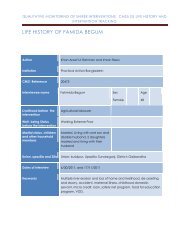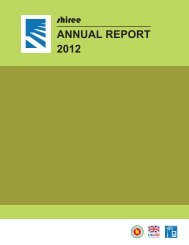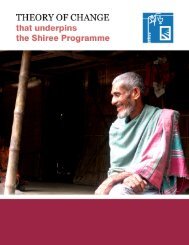LIFE HISTORY OF HALIMA BEGUM - Shiree
LIFE HISTORY OF HALIMA BEGUM - Shiree
LIFE HISTORY OF HALIMA BEGUM - Shiree
You also want an ePaper? Increase the reach of your titles
YUMPU automatically turns print PDFs into web optimized ePapers that Google loves.
QUALITATIVE MONITORING <strong>OF</strong> SHIREE INTERVENTIONS: CMS5 (S) <strong>LIFE</strong><strong>HISTORY</strong> AND INTERVENTION TRACKING<strong>LIFE</strong> <strong>HISTORY</strong> <strong>OF</strong> <strong>HALIMA</strong> <strong>BEGUM</strong><strong>Shiree</strong> Q2 Research on Extreme Poverty in BangladeshAuthorInstitutionProkriti NokrekSave the Children UKInterviewee name Halima Begum Sex Female Age 46Livelihood beforethe interventionWell- being StatusbeforetheinterventionMarital status,children and otherhousehold membersHousewifeDestituteWidow, living with fourchildren (3 sons and 1daughter).She had 9 children.union, upazilla andZillaBagerhatDates of Interview 1st 08/12/10, 2 nd 20.12.10, 3 rd 06.06.11, 4 th 25.07.11KeywordsSeparation of 2 male breadwinners, injury of the third, deathof the husband, Destitution, deprived of land inheritance,large number of children, natural disaster, extreme poormarriage,INTRODUCTIONFor those romantic about the power of traditional support networks for women whoare devout, this is a cautionary tale. Halima was the first child of her father’s first wife,who went on to marry another four wives. Her mother and her siblings ultimately hadto find their own source of support despite his much better economic position andmother became a labourer and Halima a domestic maid. She was married at 13 toan exceptionally poor man whose mother was a beggar with no ceremony. Whilstshe was asked by both her grandfather and father to care for them whilst ill, theypromised her land for doing so, both times she never got any of it. Her brother keepsthe 40 decimal lands and the some 200 betel nut and coconut trees on it. When sheneeded a document to show her ownership of her 3 decimals of homestead landownership in order to get support to rebuild her house after a cyclone he denied her1
QUALITATIVE MONITORING <strong>OF</strong> SHIREE INTERVENTIONS: CMS5 (S) <strong>LIFE</strong><strong>HISTORY</strong> AND INTERVENTION TRACKINGProductive assets rankedthem in terms of value(e.g. land, livestock, ourrickshaws),Her third sonVan Puller (hiring a van for 20 taka per day) andused to get 60-80 taka per day but not on a regularbasis.Halima has no productive assets.Her brother is now taking the major portion ofbenefits of her father’s 40 decimal homestead landand the some 200 betel nut and coconut trees onthe land. These should be shared 6 ways betweenHalima’s and her sisters (3), brother (1), mother andher step mother.Fuel woods are available near to her house (withintheir homestead land) and she collects thosewithout any cost.House and homestead:ownership, condition oftenure, condition of house.Dilapidated house of two rooms (wall made ofcoconut and goal leaf and roof material wascorrugated tin with some hole and in some portiongoal leaf).As noted earlier her father left 40 decimals land; shewill get 3 decimal of it. The property and the tress onit are still not still divided among her siblings andmother.Moreover, as this is her natal village she has relatives living nearby. Her own mother isliving with her brother’s family in the same village. Her step mother (father’s 5 th wife) isalso living alone separately in the same village.<strong>LIFE</strong> <strong>HISTORY</strong> NARRATIVECHILDHOOD AND YOUTHHalima was born in Sadhu village in 1965. There were two sisters and two brothers.She is the eldest child of her parents. She did not go school. Nor did her sisters. Hersisters had extreme poor marriages: one married an agricultural day labourer whoharvests paddy of others for exchange of one-eighth of the portion of the crops; theother sister married a van driver. Both of them are poor now.Her brother by contrast lives in the same village and has a rice milling business. Hehas four daughters and a son. All his daughters got married in well-off families and hisson is studying in a college. He has a well structured house (with a brick made walland a roof made from corrugated tin).3
QUALITATIVE MONITORING <strong>OF</strong> SHIREE INTERVENTIONS: CMS5 (S) <strong>LIFE</strong><strong>HISTORY</strong> AND INTERVENTION TRACKINGthe marriage in accordance with Sahria (Islamic law).” On her marriage day she hadno wedding night with her husband. At that time she used to work as a housemaid inher neighbour’s house. To her, “After finishing all formalities I went back to myneighbour’s house and my husband also went back to his house.”Six months later her husband gave a new saree, blouse, and a pair of slippers to herand took her to his house. When she moved to her husband’s house she noticed thather husband had no homestead land and no proper housing. He used to live with hismother who was a beggar and live in other’s places.When she came to her husband’s house, her realisation was: “I was not a disabledperson (not deaf or dumb), why did my grandfather arrange my marriage to thisperson who has nothing?”Relationship with her husband:However whilst extremely poor with a destitute mother in-law Halima noticed that,“My husband was good and a hard worker.”In the beginning her husband did not allow her to go to any of their neighbourshouses, because he had two more wives who had left him because of this extremepoor condition. Her husband feared that Halima would do the same.After her marriage her father and brother never visited to her. So her husband hadsympathy with her and always made a joke that Halima is like a floating banana tree,so she will never go back to her parent’s house.Halima also added that her husband never tried to disturb anyone. Despite their foodshortages, her husband used to tell her: “We have got large number of children (9),do not visit relatives house, they will be annoyed for our children.”Relationship with her mother-in-lawShe had good relationship with her mother-in-law. Her husband used to tell his mothernot to scold her. Her mother-in-law was a beggar, when she used to get any goodfood from someone; she used to keep it for Halima.Socio-economic status after marriageHalima’s husband was a day labourer and fuel wood collector and used to earn 150-200 taka in a day. He sometimes used to row a boat to ferry people and often wentto the Sundarban forest area to collect wood. She remarked “My husband would doany kind of laborious job that he got”. According to Halima, they were quite goodand her family was running smoothly after her marriage. She had some goats, poultryand duck. After her marriage she lived in Randa (where her husband took her) for 12years.Children’s information5
QUALITATIVE MONITORING <strong>OF</strong> SHIREE INTERVENTIONS: CMS5 (S) <strong>LIFE</strong><strong>HISTORY</strong> AND INTERVENTION TRACKINGHer first child was born in the third year of her marriage and with an interval of 2 to 3years she conceived and gave birth to nine children at her own home. All of herdeliveries were a normal process with the help of a traditional-neighbor birthattendant. She said, “My children were very good, they listened to me. Despite ourfood crisis my children never asked for food from my neighbours or villagers until Ipermit them to.”Grandfather promised land but never gave her it even though she took care of himHalima’s grandfather visited her house and promised to give her 7.5 decimal ofhomestead land to her. When her grandfather was suffering from paralysis she wentback in her grandfather’s place and took care of her grandfather. But hergrandfather did not keep his promise and did not give her any land before his death.So they used to live in a government khas land beside the river bank.Eldest son’s marriage in 1999Her eldest son got married in 1999. After getting married her eldest son used to sonused to help his parents. He used to help his father at work e.g. boats and going tothe forest to get fuel wood together.Income reduced due to eldest son’s migration in 2001Two years later her eldest son migrated to Feni (another district) with his family. At thattime they had a child and there were no work opportunities within this locality. Nowhe is working in a brick field as a day labourer and goes for other work if there isscope. His wife also works as a domestic helper. They usually visit once a year. Duringtheir visit, when they stay with Halima, they buy some food items. Otherwise they donot have the ability to provide financial help.Support from a school teacher (1995-2005)Three of Halima’s daughters gradually stayed in one of school teachers’ homes atRanda. The teacher did not give them any cash for working at her home butprovided them with food and schooling costs up to class five.DAUGHTER’S MARRIAGE AND ITS IMPACT ON THIS FAMILY (<strong>HALIMA</strong>’S <strong>LIFE</strong>)Marriage of eldest daughter in 2001Halima’s husband arranged her eldest daughter’s marriage to a carpenter in Kusthia.During her marriage her husband spent about 7000 (seven thousand) taka from hisearning. During her eldest daughter’s marriage her son-in-law did not have anydowry demands. She did not need to think about her daughter’s marriage. Herhusband managed the cost of all of her daughter’s marriage.6
QUALITATIVE MONITORING <strong>OF</strong> SHIREE INTERVENTIONS: CMS5 (S) <strong>LIFE</strong><strong>HISTORY</strong> AND INTERVENTION TRACKINGassets but took away all my happiness”. At that time, she became helpless. The UnionParishad chairman gave her 5000 taka to repair her house but most of this amountwas spent on treatment of her husband.Her third son migrated to India in 2007: After the death of her husband, her third sonwas puzzled about what to do. He was working in Feni in a rickshaw garage and got3000.00 (three thousand) taka. He decided to migrate to Delhi (India) with the help ofone agent. The agent charged 7000 taka to send him to Delhi. He paid 3000 takabefore leaving Bangladesh and after starting his work in India he paid the rest of themoney. He used to work in a vang gari shop (garbage business).Relief and VGF support from Union Parishad (in 2007)After cyclone SIDR Halima received 15 kgs of rice for 5 times from the VulnerableGroup Feeding (VGF) programme. A Union Parishad member also provided 5000.00(five thousand) taka to repair their house.Second son involved with food for work programmeAfter cyclone SIDR her second son got involved in a pond digging programme for 20days organised by World Vision Bangladesh. World Vision Bangladesh provided 50 kgsof rice, salt, oil and lentils at that time.Engaged with road construction work in 2008After cyclone SIDR Halima engaged with road construction work for two times (15 +30=45 days) receiving 100 taka per day. Despite her restriction about working outsidein public places she did work like this two times. She shared that she used to workwearing borkha 1 . It was very difficult to work wearing borkha during the hot weather,but that she wore it to maintain purdah 2 . At the end of the work she went to people’shouses to clean her borkha and then back to her house so that other villagers wouldnot notice that she had worked on the road.Unfriendly relationship with her younger brotherAfter cyclone SIDR, the Government of India provided some housing grants tocyclone affected households. Union Parishad members prepared the list to providethese housing grants. To get this grant people had to show their documents/papers ofhomestead land. Halima was also enlisted to get this grant which is worth of taka1,40,000 (one lac forty thousand taka). But her younger brother did not provide thedocument of his homestead land and as such she did not get the housing grant. Sheexpressed her sorrow,“My brother knows how I am struggling with my children, he knows what happenedin my life during cyclone SIDR, but he did not help me.”1 An enveloping outer garment worn by women in some Islamic traditions to covertheir bodies in public places.2 The practice of concealing women from men.8
QUALITATIVE MONITORING <strong>OF</strong> SHIREE INTERVENTIONS: CMS5 (S) <strong>LIFE</strong><strong>HISTORY</strong> AND INTERVENTION TRACKINGFrom that time she stopped talking to her brother and did not visit his house.Survival strategies (2007-2009)After the death of her husband she worked two times in a SIDR recovery programme.She also had to work in other villagers’ houses as a domestic helper but this wasirregular work. At that time her second son was with her and he used to work as daylabourer and sometimes used to pull a van. She said: “We always had insufficientfood for round the year.”Road accident of her third son (2009)Halima's son had a road accident by a running car when he was walking through theroad. His left leg then became broken. The Indian police sent him to the hospital andhe received treatment. He had no money with him, so he surrendered to the policehimself and the police sent him back to Bangladesh. He came back to Bangladesh in2009 and started pulling a van, but with high risk as one of his legs is bonded with aniron-rod. The doctor said that he needs a leg operation after several months.LATE ADULTHOODSecond son marriage in 2009Halima’s husband arranged his second son’s (Rubel) marriage at the age of 15. Buthis son did not continue his relationship with his wife and divorced her with his secondson two months later. To them, his wife was not a good girl and had a relationshipwith another man. Her second son got married again in 2009 and he has onedaughter.Second son’s migration to IndiaLast year (in 2010) her second son migrated to India (Delhi) but Halima’s daughter-inlawand granddaughter are not staying in her house (her daughter in-law is staying inher natal home).Well-being linked to the death or separation of male household members:Halima feels that after her husband died, her brother let her down by not giving herhis inheritance and sons let her down in separating out of the family household.According to Halima,“Crisis began for me when husband died in 2007 and when my two sons separatedone after another immediately after their marriage”.She expressed her sorrows that“We are poor, nobody loves the poor”Recalling her past she also added that,9
QUALITATIVE MONITORING <strong>OF</strong> SHIREE INTERVENTIONS: CMS5 (S) <strong>LIFE</strong><strong>HISTORY</strong> AND INTERVENTION TRACKING”my husband tried to maintain prestige by arranging rich food (fish and meat) for thedaughter’s husband when they visited at home but I can provide only rice andvegetables to them”.She expressed about her present condition comparing with her two sisters that“They have their husband”So they have someone to depend on for economic support.SUMMARY AND CONCLUSIONSHalima’s father’s polygamous tendency forced her to work as a housemaid in othervillagers’ houses, because despite her father’s ability, he did not take care of all of hischildren.Halima’s grandfather arranged her marriage to an extremely poor person who hadno homestead land and only a dilapidated house. Natural disasters (cyclone SIDR in2007) also caused damages to her few assets that she had invested in from herhusband’s earning.The death of her husband and the separation from her two sons after their marriagemade her more vulnerable.In addition to this, her grandfather, father and younger brother deprived her fromland inheritance.Halima is now in late adulthood; facing a decreased working capacity and reducedsupport from adult earning members (eldest and second son) after their marriage.She also has three dependents and only one son involved with irregular van pulling.10
QUALITATIVE MONITORING <strong>OF</strong> SHIREE INTERVENTIONS: CMS5 (S) <strong>LIFE</strong> <strong>HISTORY</strong> AND INTERVENTION TRACKINGLife history map of Halima Begum (46)654Father’s married5 wives leadingto thedownwardmobility of his firstwife’s family whoultimatelyseparated fromeconomicsupportGot married at 13 to anextremely pooragricultural labourer andmother in law was abeggar.Eldest daughter’smarriage spentsavings.Cyclone SIDR,received relief andengaged with Cashfor WorkDeath of herhusbandWorked as domestic helperand depends on 3 rd son’sirregular earningMigration of 2 nd sonand reduced incomeDeprived of landinheritance3Halimaengaged asdomestichelperMigration of elderson and reducedincome /kept itlow.2 nd daughter’smarriageThirddaughter’smarriageThird son’saccident21Support fromschool teacherFather’sdied519651974 1978Time1995112001 2003 2004 2005 2006 2007200920102011S
.12









